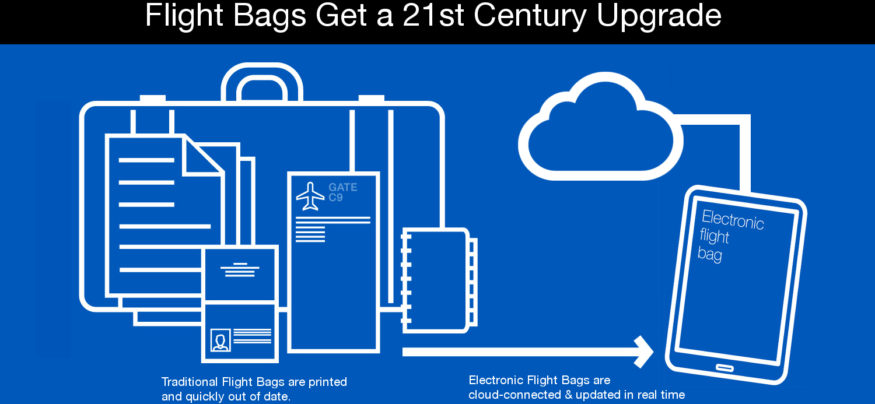Traditional paper flight manuals are finally losing their tight grip on the airline industry. In a world accustomed to instant communication, it might be hard to believe that airline flight procedure manuals are often still printed on sheets of paper. They’re punched, bound, wrapped and shipped across the world, a process that can take weeks. However, electronic flight bags are bringing newfound speed and innovation to the cockpits and flight cabins of the world’s passenger jets.
A Cumbersome, Outdated Process
Updating paper manuals is an intricate and time-consuming process that often leaves pilots with little time to digest information. It’s also costly and slow; with each change, a new version has to be published, and some new regulations or guidelines released in the interim might have to wait for the next edition. This reduces the productivity of crews and pilots, who should be spending their work time solving problems instead of organizing updates.
On the back end, the technical writing department is incredibly busy keeping up with the federal government’s required revisions, aircraft manufacturer technical updates and internal policy changes. Once all of these changes have been reviewed and approved, this same department must also handle the printing and distribution. Hundreds of reams of paper are printed and distributed to every crew member at airports around the country or the world. They’re then unwrapped and put into each employee’s file. Crew members can spend up to an hour putting the updated materials into the relevant binders. This is valuable time that could, instead, be used to read the updated information, allowing crews to get back to their daily tasks faster.
What’s more, these paper manuals become bulky, contradictory and difficult to navigate over time. Fortunately, electronic flight bags can make this tedious process cheaper, quicker and more effective by publishing updates electronically and simultaneously to all users. What used to take weeks can now take mere minutes. Additionally, users can now certify that they’ve read and understood the information the moment they finish reading it.
The Ease of Electronic Information in Aviation
Not only are electronic documents easier to update and cheaper to distribute, they’re also easier to use. Good mobility solutions do more than put paper manuals on mobile devices; they reorganize information into a new, more interactive architecture that help crew members manage their workload. In particular, airline pilots need quick, easy access to information to make good decisions. One feature of a good electronic flight bag is readability. Mobile platforms allow pilots to zoom in, out and across information to quickly find the data they need, especially when reviewing checklists or charts. Some solutions also include a dark mode, which is crucial for night and low-light flying. Inverted colors allow pilots to quickly transition from screen to instruments and sky with minimal eye adjustment.
When organizing information, pilots often mark their paper manuals with highlights, margin notes or custom tabs. These shortcuts make the document easier to navigate, but when that section of the manual gets updated, pilots lose those notes unless they take the time to copy them onto the new sheets. Well-designed electronic mobility solutions can preserve annotations from one update to the next, vastly improving their usefulness to the end user. Additionally, pilots can layer sections to improve navigation, shrinking and expanding various sections as needed and focusing only on relevant information.
Comply365 and Samsung have partnered to provide all of these key features. A Samsung Galaxy tablet equipped with Comply365’s electronic flight bag solutions gives airlines a flexible array of products to meet any situation and budget. On the back end, technical writing departments can push out manual updates as needed and require crew members to enter a code when they’ve finished reading. This helps ensure compliance when distributing new regulations. Further, the software can manage online training, safety management programs, electronic forms, weather and safety reports and passenger service updates, sending information to the cloud from the mobile platform even when in flight.
Forecasting the Future
Perhaps the most exciting part of electronic flight bags is what they’ll be able to do in the future with dedicated in-flight connectivity. While passenger Wi-Fi® networks are now common, many airlines restrict crew member use due to security concerns and avionics restrictions. However, with full-time secure connectivity, mobility solutions will be able to easily access and alert staff to critical information.
The most potent example of electronic flight bags’ connectivity is when there’s an in-flight medical incident. Today, flight attendants assess the situation and pass information along to the pilots, who relay the passenger’s vitals via radio to a doctor on the ground. The doctor then passes medical treatment advice back to the pilots, who relay the message to the flight attendants. The doctor also advises the flight crew whether or not it should divert the plane to the nearest airport.
With mobility solutions, a much better approach would be to have the flight attendant establish a live-stream videoconference link to let the doctor see the patient firsthand. This would improve the doctor’s ability to assist and keep the pilot from being a medical intermediary, allowing the pilot to focus on flying. Leveraging the power of mobility during medical emergencies is simpler, easier and more effective than current processes.
Pilots and crew members spend a lot of time solving problems. Whether it’s late airplanes, passenger requests, crew rest issues or mechanical discrepancies, there are endless opportunities to exercise problem-solving skills. As mobile solutions make their way into the aviation industry, these processes will only improve, making the whole journey safer and more efficient.
Learn more about how Comply365 and Samsung are using tablets to enable companies to streamline their operations and ensure compliance with company policies and government regulations.







